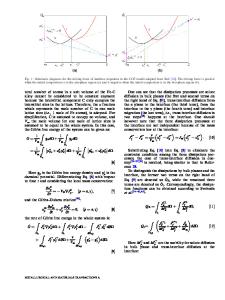Energy principle of indentation contact: The application to sapphire
- PDF / 1,124,496 Bytes
- 11 Pages / 612 x 828 pts Page_size
- 40 Downloads / 394 Views
The recently developed energy principle of indentation mechanics was applied to the continuous indentation test performed on pure sapphire. Three crystallographic planes, M = (10T0), A = (1210), and C = (0001), have been indented by a symmetrical triangular pyramid (Berkovich). The distinct anisotropic behavior of the indented crystal has been observed for the maximum indentation loads of 1.961 N, 0.686 N, and 0.392 N. The indentation hysteresis loop energy and the related "true hardness parameter" have been determined for various crystallographic orientations, as well as for two different orientations of the indenter. The observed effects have been discussed in terms of the energy principle of indentation with crystallographic considerations. The effective resolved shear stresses for the slip and twinning systems were calculated and applied to the anisotropic indentation behavior. It was concluded that the energy principle is highly recommended for analyzing the data of continuous indentation tests.
I. INTRODUCTION The hardness test has always been considered to be one of the simplest and the fastest techniques for gathering a variety of experimental data on the mechanical properties of solids. However, the great progress in the indentation field recently taking place was never expected in such a scale even a few years ago. The rapid development of so-called "advanced materials" has added new requirements for the theoretical description of the material structure and related properties, as well as new restrictions on the testing methods. Since in "advanced materials", quite often the mass volume available for experimental investigations is very small (e.g., materials with surfaces modified by the energetic ion implantation, small volume crystals for microelectronics, etc.), the indentation technique appears naturally as an invaluable method for examining the mechanical properties of these solids. However, the classic hardness measurement test is often an insufficient method to estimate the plastic properties in near surface region, particularly for brittle ceramic-based materials, because of the limited accuracy exhibited especially in the low-load indentation region. Recent developments in hardness testing have enabled continuous monitoring of the load and the depth of penetration experienced by the indenter during the indentation process. This not only makes it possible to eliminate the limitation of the resolution and efficiency of the optical system attached to the hardness tester, but also allows one to derive new information about the complex mechanical behavior 1068
http://journals.cambridge.org
J. Mater. Res., Vol. 8, No. 5, May 1993
Downloaded: 04 Apr 2015
of materials deformed in a very shallow subsurface region. The continuous indentation technique is a unique method available for studying the mechanical properties of the region of interest. Studies on micro- and nanoindentation processes create a new and expanding area of interest. The idea of depth-sensing hardness measurements which allow estimat
Data Loading...











